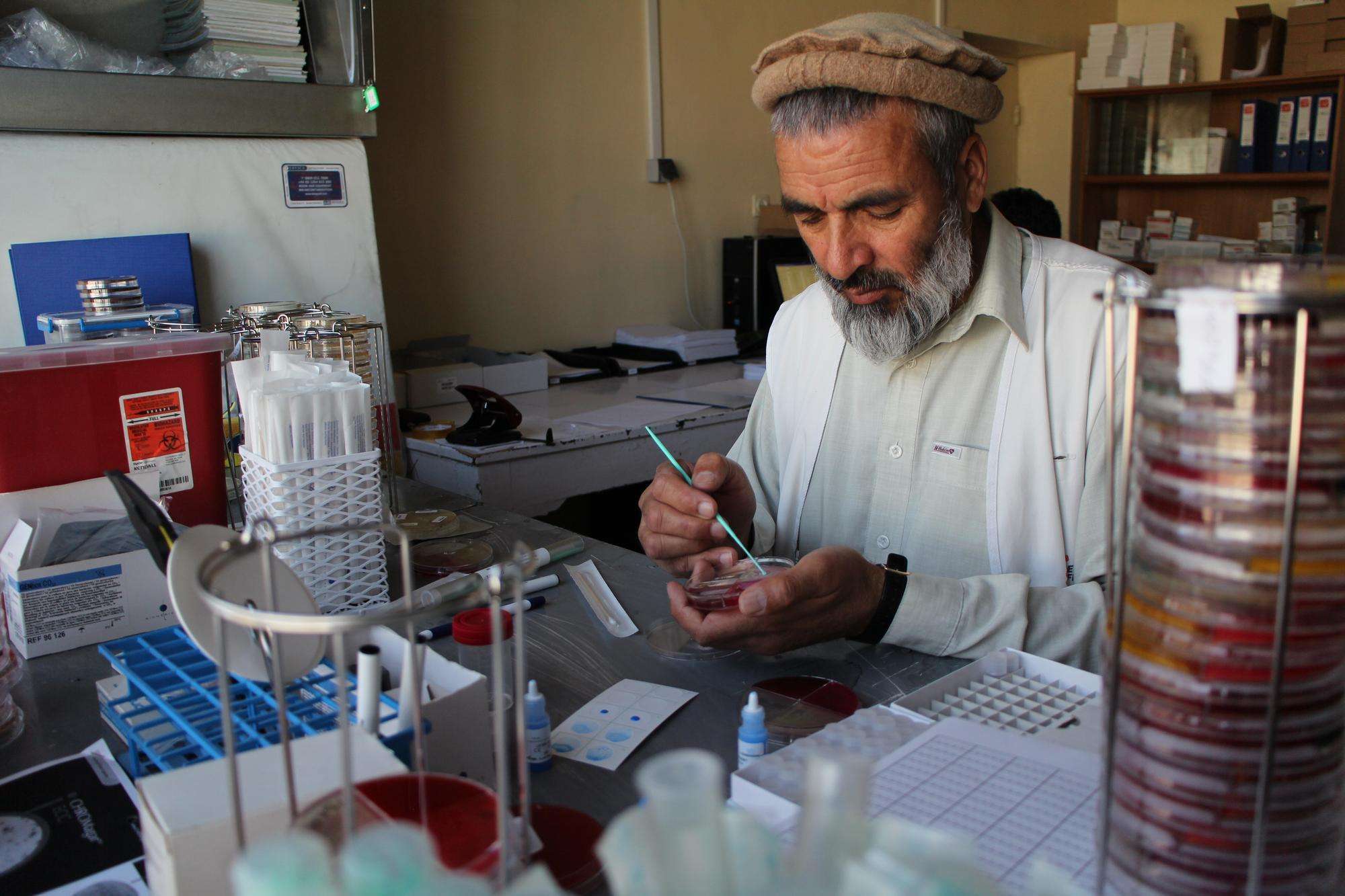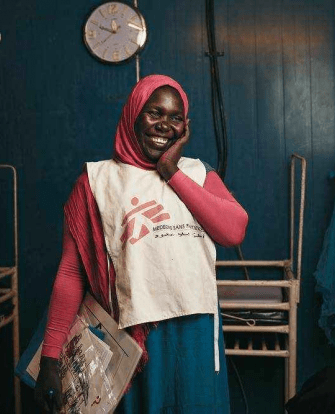In response, we have developed a comprehensive strategy to detect, treat, and prevent antibiotic-resistant infections. Our strategy focuses on a few key pillars:
- Ensuring stringent hygiene in our hospitals and clinics to prevent transmission of infection between patients;
- Expanding access to microbiology-based diagnosis;
- Providing good quality of care aimed at saving lives and limbs of people with resistant infections, while ensuring that antibiotics are prescribed and used appropriately;
- Building local capacity to implement our package of care.
Alongside these core activities, we conduct research on new tools to support these activities. We also engage with global health policymakers on ways to eliminate practices that fuel the spread of antibiotic resistance, and to accelerate the development of urgently-needed new types of antibiotics.
Reinforcing infection prevention and control
While most patients diagnosed with ABR infections developed them before seeking treatment, resistant bacteria can also spread within healthcare facilities. This is a significant problem even in high-income countries, but safeguards against transmission in hospitals and clinics—including basic handwashing and thorough disinfection of all surfaces and medical devices—are more often lacking in under-resourced facilities with high patient loads.
Establishing these safeguards at our projects requires well-planned protocols and trained staff. For example, patients at our specialized burn unit in Drouillard Hospital in Port-au-Prince, Haiti must have their bandages changed every other day until the burns are fully healed. Since these changes can take up to two hours—ample time for bacteria to invade a wound—the procedure must be done in a sterile operating room by staff covered in protective garments. Another less obvious but crucial safeguard is finding space to isolate patients with ABR infections to prevent transmission. These measures can be especially challenging to maintain in emergencies when hospitals receive many wounded or sick patients in a very short time, often requiring a constant and difficult balancing act for our teams.
Improving access to microbiology-based diagnostics
Another crucial part of our strategy is expanding access to laboratories that can accurately diagnose a patient’s infection and test the underlying pathogen for resistance. This is challenging in most settings where we work, where there's often a scarcity of well-equipped microbiology labs with skilled staff who can conduct the necessary tests and correctly interpret the results.
To meet this need, our first step is to look for an existing lab accessible to a given project. If we find one that meets our quality standards and can work with us, we use it, sometimes after helping to build up equipment, supplies, skills, or capacity. In settings without labs and where the need is great, we may build our own and train local staff to run it, and then provide external support as needed. This has succeeded even in some extremely difficult contexts—for example at our trauma hospital in Aden, in war-torn Yemen, a country where the health system is in ruins. As of mid-2019, we have established microbiology labs at six projects, with four more planned in the near future.
Caring for patients with infections while optimizing antibiotic use
Our approach to managing bacterial infections is to use antibiotics that narrowly target the pathogen causing a patient’s illness and that lab tests show will kill it. Only when these tests identify a bacteria showing resistance—or when the patient needs immediate treatment for a life-or-limb-threatening infection, or when microbiological testing is not possible—do we use broader drugs, or even “last-resort” antibiotics for the most resistant infections.
Treatment for ABR infections is typically long. While patients with a simple infection might need only a week's treatment in the hospital, those with resistant infections typically require six weeks of intravenous antibiotics followed by four weeks of oral drugs. During this period, some patients may also need surgeries—for example, for severe burns or orthopedic injuries. To prevent resistant infections from spreading to others, these patients are isolated from other patients, which can take an emotional toll.
Another important part of care is providing psychological support and counseling to patients undergoing these difficult treatments, especially to those in isolation.
Preserving antibiotics through "antibiotic stewardship"
As the number of useful antibiotics shrinks in the face of growing resistance, it’s crucial to preserve the effectiveness of those we still have. Our goal for every patient with a bacterial infection is to use the right antibiotic at the right dose for the right length of time, and by the right route of administration (oral or intravenous). This helps not only to optimize care for each individual but also to avoid using the broadest, “last resort” antibiotics when they’re not needed.
About half of all MSF projects, especially those focused on trauma and surgery, have implemented an “antibiotic stewardship” program to help meet these goals. Our programs bring together a small team of people with relevant expertise—infectious diseases specialist, infection control expert, and pharmacist—to review all antibiotic prescriptions at the hospital or clinic, monitor antibiotic prescribing practices, and investigate suspected outbreaks of antibiotic-resistant infections within the hospital.
Building capacity
Health workers and lab technicians in regions where we work are often unfamiliar with how to recognize and respond to ABR infections. So our ABR response includes working to build this capacity—from hands-on training of lab technicians to perform diagnostic tests and of doctors to interpret the results, to establishing more rigorous handwashing protocols and implementing antibiotic stewardship programs. E-learning tools and a standardized training curriculum are also in development.
One success story is the MSF acute trauma facility in Aden, Yemen, where local staff with no prior microbiology education now run a lab capable of sophisticated, high-quality microbiological testing, including on bone and tissue samples. They also conduct antibiotic stewardship activities to support the project’s intensive care and surgical wards, providing daily feedback about laboratory results and regular audits of prescribing practices and antibiotic consumption.
Much of this training was done by bringing Aden staff to the MSF hospital in Amman, Jordan, a referral center for joint, bone, and tissue injuries, to spend time working and learning alongside counterparts experienced in managing ABR. The Jordan project also provides ongoing remote support to the Aden project.
Developing innovative tools
To help expand microbiology capacity even further in low-resource and emergency settings, MSF is developing a “Mini-Lab” — a simplified, small-scale, “all-in-one,” pre-fabricated clinical bacteriology laboratory, stocked with everything needed to carry out the most important diagnostic tests. MSF designed the Mini-Lab so it can be easily assembled and used by people with limited training. The Mini-Lab is a portable, affordable toolkit that will allow for better diagnosis and treatment of infections, and for surveillance of ABR, even in remote, extremely hot and under-resourced settings.
The first pilot deployment of Mini-Lab was completed in 2020 in Haiti. In 2021 we will pilot implementation at a district hospital in Carnot, Central African Republic, aimed at optimizing use of Mini-Lab in a routine laboratory within a busy clinical environment. The goal is to roll out full deployment in selected MSF projects at the end of 2021.
Another innovative tool in development is a smartphone app designed to help doctors and clinicians in low-resource settings diagnose ABR. ASTapp, as it is called, uses image processing and artificial intelligence technology to guide non-expert microbiologists through interpretation of lab tests that measure resistance to antibiotics. This, in turn, guides clinicians on the best course of treatment and will help ensure that patients receive the most appropriate antibiotics. ASTapp was developed by the MSF Foundation, a specialized unit focused on innovation, through a $1.3 million Google Artificial Intelligence Impact Challenge grant.
A third tool we developed, called MSFeCARE (electronic Clinical Algorithm and Recommendation), helps clinical staff choose an appropriate antibiotic for acutely ill children (from two months to five years old) in regions where diagnostic tests aren't available. Using a tablet, eCARE guides healthcare workers step-by-step through an assessment of the patient’s symptoms and signs. It then provides recommendations and standardized procedures to diagnose and treat the child. We are using eCARE in remote projects, including those in Mali, Niger, Nigeria, Tanzania, Chad, and Central African Republic.
Watch this panel discussion between MSF experts to learn more about how we are fighting ABR.




